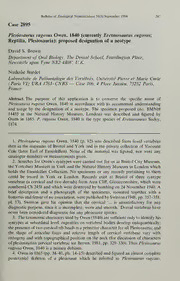
Case 2895. Pleisiosaurus Rugosus Owen, 1840 (Currently Eretmosaurus Rugosus; Reptilia, Plesiosauria): Proposed Designation Of A Neotype PDF
Preview Case 2895. Pleisiosaurus Rugosus Owen, 1840 (Currently Eretmosaurus Rugosus; Reptilia, Plesiosauria): Proposed Designation Of A Neotype
Bulletin ofZoological Nomenclature 51(3) September 1994 247 Case 2895 Plesiosawus rugosus Owen, 1840 (currently Eretmosaurus rugosus; Reptilia, Plesiosauria): proposed designation of a neotype David S. Brown Department ofOral Biology. The Dental School, Framlington Place, Newcastle upon Tyne NE2 4BW. U.K. Nathalie Bardet Laboratoire de Paleontologie des Vertebres. Universite Pierre et Marie Curie (Paris VI) URA 1761-CNRS— Case 106. 4 Place Jussieu, 75252 Paris, France Abstract. The purpose of this appHcation is to conserve the specific name of Plesiosawus rugosus Owen, 1840 in accordance with its accustomed understanding and usage by the designation of a neotype. The specimen proposed (no. BMNH 14435 in the Natural History Museum, London) was described and figured by Owen in 1865. P. rugosus Owen, 1840 is the type species of Eretmosaurus Seeley, 1874. 1. Plesiosaurus rugosus Owen, 1840 (p. 82) was described from fossil vertebrae then in the museums of Bristol and York and in the private collection ofViscount Cole (later Earl of Enniskillen). None of the material was figured, nor were any catalogue numbers or measurements given. 2. Searches for Owen's syntypes were carried out for us at Bristol City Museum, the Yorkshire Museum in York and the Natural History Museum in London which holds the Enniskillen Collection. No specimens or any records pertaining to them could be traced in York or London. Records exist at Bristol of three syntype vertebrae (a cervical and two dorsals) from Aust Cliff, Gloucestershire, which were numbered Cb 2458 and which weredestroyed by bombing on 24 November 1940. A brief description and a photograph of the specimens, mounted together with a humerusandfemurofnoassociation,werepublishedbySwinton(1948,pp. 357-358, pi. 13). Swinton gave his opinion that the cervical "... is unsatisfactory for any diagnostic purpose, since it is incomplete, worn and smooth." Dorsal vertebrae have never been considered diagnostic for any plesiosaur species. 3. ThetaxonomiccharactersusedbyOwen(1840)aresufficientonlytoidentifyhis syntypes at subordinal level: rugosities on vertebral bodies develop ontogenetically; thepresenceoftwocervicalribheads isaprimitivecharacterforall Plesiosauria; and the shape of articular faces and relative length of cervical vertebrae vary with ontogeny and with topographical position on the neck (for discussion ofcharacters ofplesiosaurian cervical vertebrae see Brown, 1981, pp. 329-330). Thus Plesiosaurus rugosus Owen, 1840 is a nomen dubium. 4. Owen in 1865 (pp. 34-40, pis. 14-15)described and figuredan almostcomplete postcranial skeleton of a plesiosaur which he referred to Plesiosaurus rugosus. 248 BulletinofZoologicalNomenclature51(3)September 1994 believing it to belong to his (1840) nominal species. The specimen, from the 'Lower LHiiasstoorfy LMeuicseestuemrsh(icraeta.lo.giunetnhuemnbeeirghBbMouNrhHoo1d44o3f5)G.ranby', is now in the Natural 5. Seeley(1874, p.445)made P. rugosiisOwen, 1840thetypespeciesbymonotypy of his new genus Eretmosaurus. His diagnosis gives characters shown by Owen's (1865) specimen and a detached pectoral girdle (BMNH 2041). BMNH 6. Lydekker (1889, pp. 249-250), when cataloguing 14435 as Eretmo- saurusrugosus(Owen, 1840), stated that it did not appearabsolutelycertain that the vertebrae were identical with Owen's types, and concluded that '... the species must date from the description ofthe undermentioned skeleton' (i.e. from Owen, 1865). 7. Eretmosaurus rugosus (Owen, 1840) has been used as a valid name since 1874 BMNH although descriptions refer only to specimens 14435 and 2041. Diagnostic characters include the total number of cervical vertebrae and the structure of the pectoral girdle, which could not have been known from the syntypes. Owen's description of 1840 and the original syntypic series of isolated vertebrae, not diagnostic ofa single species-group taxon, have remained forgotten in the primary literature since Lydekker's catalogue of 1889. 8. Although P. rugosushas been treated in the taxonomic sense ofOwen (1865) it has generally been cited with the date 1840. To avoid confusion and nomenclatural instability we propose the designation of specimen number BMNH 14435 in the Department of Palaeontology of the Natural History Museum, London as the neotype ofPlesiosaurus rugosus Owen, 1840. 9. The International Commission on Zoological Nomenclature is accordingly asked: (1) to use its plenary powers to set aside all previous fixations oftype specimens for the nominal species Plesiosaurus rugosus Owen, 1840 and to designate specimen BMNH 14435 in the Natural History Museum, London as the neotype; (2) to place on the Official List of Generic Names in Zoology the name Eretmosaurus Seeley, 1874 (gender; masculine), type species by monotypy Plesiosaurus rugosus Owen, 1840; (3) to place on the Official List of Specific Names in Zoology the name rugosus Owen, 1840, as published in the binomen Plesiosaurus rugosus (specific name ofthetype speciesofEretmosaurusSeeley, 1874)andasdefinedbytheneotype designated in (1) above. Acknowledgements We thank Dr P.R. Crowther {Bristol City Museum), MrP.C. Ensom (The Yorkshire Museum. York) and Dr A.C. Milner (The Natural History Museum. London) for searching for Owen's 1840 syntypes in their collections. References Brown, D.S. 1981. The English UpperJurassic Plesiosauroidea (Reptilia)and a review ofthe phylogeny and classification ofthe Plesiosauria. Bulletinofthe British Museum (Natural History) (Geology). 35(4): 253-347. Lydekker, R. 1889. Catalogue of the fossil Reptilia ami Amphibia in the Brili.sh Museum INaturalHistory). Part 2. Containing theorders Ichlhyopterygia amiSauropterygia. 307 pp. British Museum, London. BulletinofZoologicalNomenclature 51(3) September 1994 249 Owen, R. 1840. Report on British fossil reptiles. Part 1. Reportsoj the British Associationfor the Advancement ofScience. 9: 43-126. Owen, R. 1865. Monograph of the fossil Reptilia of the Liassic Formations. Part 3(1). Sauropterygia. PalaeonlographicalSociety (Monographs), X-Ad. Seeley, H.G. 1874. Note on some generic modifications of the plesiosaurian pectoral arch. QuarterlyJournalofthe GeologicalSociety ofLondon, 30: 436-449. Swinton, W.E. 1948. Plesiosaurs in the City Museum, Bristol. Proceedings of the Bristol Naturalist Society, 27(4): 343-360.
